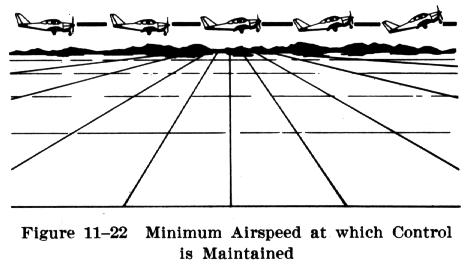
This maneuver demonstrates the flight characteristics and degree of controllability of an airplane at its minimum flying speed. The ability to determine the characteristic control responses of any airplane is of great importance to pilots. They must develop this awareness in order to avoid stalls in any airplane they may fly at the slower airspeeds which are characteristic of takeoffs, climbs, and landing approaches.
Maintaining sufficient lift and adequate control of an airplane during maximum performance maneuvers depends upon a certain minimum airspeed. By definition, the term "flight at minimum controllable airspeed" means a speed at which any further increase in angle of attack or load factor, or reduction in power will cause an immediate stall. This critical airspeed will depend upon various circumstances, such as the gross weight and CG location of the airplane, maneuvering load imposed by turns and pullups, and the existing density altitude.
The objective of maneuvering at minimum controllable airspeed
then, is to develop the pilot's sense of feel and ability to use the controls
correctly, and to improve proficiency in performing maneuvers in which
very low airspeeds are required.
Practice in flight at minimum control speeds should cover
two distinct flight situations: (1) establishing and maintaining the airspeed
appropriate for landing approaches and go-arounds in the airplane used;
and (2) turning flight at the slowest airspeed at which the particular
airplane is capable of continued controlled flight without stalling.
Maneuvering at minimum control speed should be performed using both instrument indication and outside visual reference. It is important that pilots form the habit of frequent reference to the flight instruments for airspeed, altitude, and attitude indications while flying at very slow speeds.
To begin the maneuver the throttle is gradually reduced
from cruising position. While the airplane is losing airspeed, the position
of the nose in relation to the horizon should be noted and should be raised
as necessary to maintain altitude (Fig. 11-22). When the airspeed reaches
the maximum allowable for landing gear operation, the landing gear (if
equipped with retractable gear) should be extended and all gear down checks
performed. As the airspeed reaches the maximum allowable speed for flap
operation, full flaps should be lowered and the pitch attitude adjusted
to maintain altitude. Additional power will be required as the speed further
decreases to maintain the airspeed just above a stall.
 |
During these changing flight conditions it is important to retrim the airplane as often as necessary to compensate for changes in control pressures. If too much speed is lost, or too little power is used, further back pressure on the elevator control may result in a loss of altitude or a stall. When the desired pitch attitude and minimum control airspeed have been established, it is important to continually cross check the attitude indicator, altimeter and airspeed indicator, as well as outside references to ensure that accurate control is being maintained. |
When the attitude, airspeed, and power have been stabilized in straight flight, turns should be practiced to determine the airplane's controllability characteristics at this minimum speed. During the turns, power and pitch attitude may need to be increased to maintain the airspeed and altitude. If an excessively steep turn is made, the loss of vertical lift may result in a stall. A stall may also occur as a result of abrupt or rough control movements when flying at this critical airspeed.
Abruptly raising the flaps while at a minimum controllable airspeed will also result in lift suddenly being lost, causing the airplane to lose altitude or perhaps stall.
Once flight at minimum controllable airspeed is set up
properly for level flight, a descent or climb at minimum controllable airspeed
can be established by adjusting the power to maintain the desired airspeed,
and simultaneously adjusting the pitch attitude as necessary to establish
the desired rate of descent or climb. A positive climb, however, may not
be possible at altitude due to a lack of available power in excess of that
required to maintain straight and level flight at the minimum controllable
airspeed. In some airplanes an attempt to climb at such a slow airspeed
may result in a loss of altitude, even with maximum power applied.